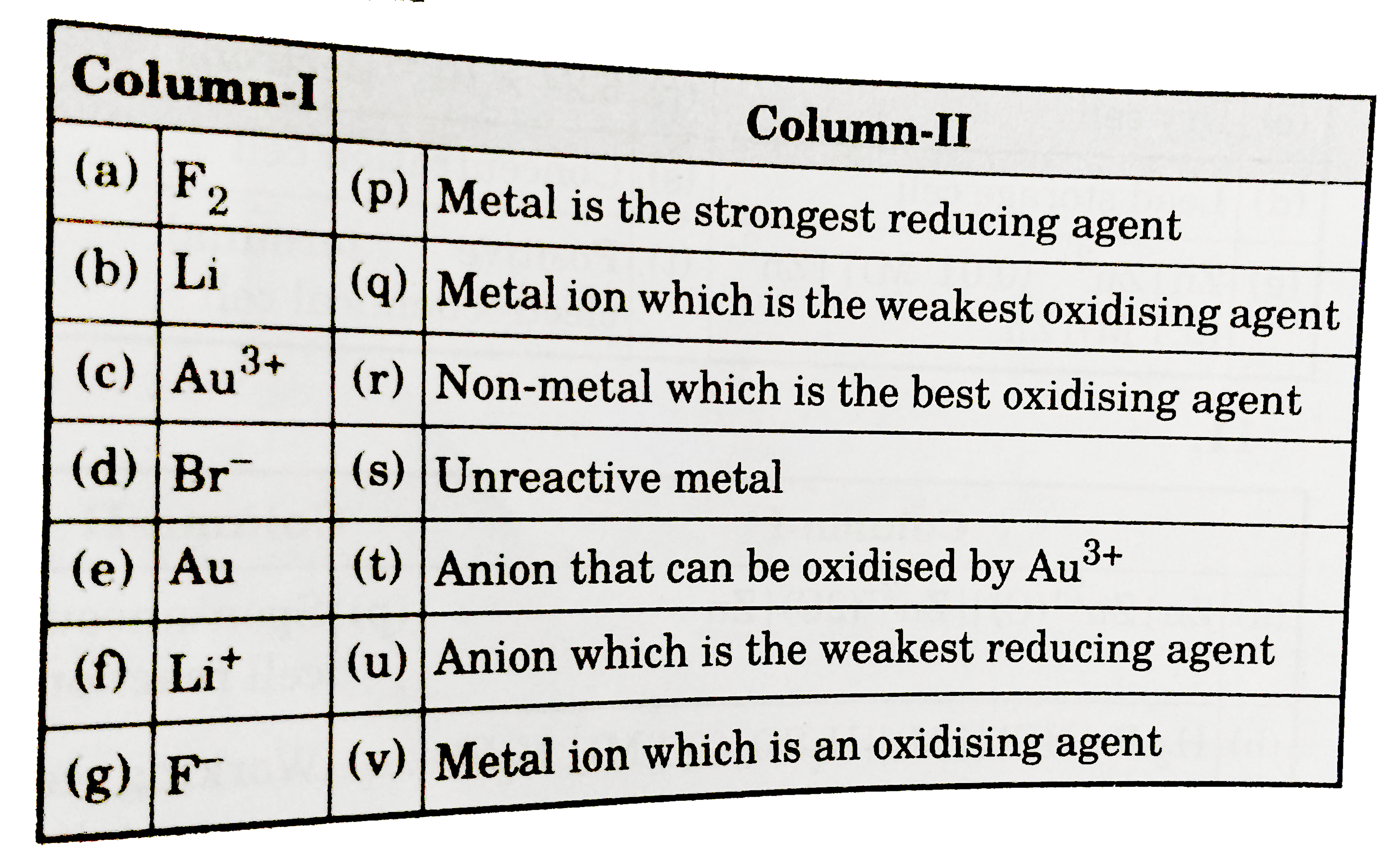If E∘Au+/Au is 1.69 V and E∘Au3+/Au is 1.40 V, then E∘Au+/Au3+ will be :
0.9 v
0.945 V
1.255 V
None of these
The correct Answer is:D
To find the standard electrode potential E∘(Au+//Au3+), we can use the given standard electrode potentials for the half-reactions involving gold:
1. Given Values:
- E∘(Au+//Au)=1.69V
- E∘(Au3+//Au)=1.40V
2. Write the Half-Reactions:
- The reduction half-reaction for Au+ to Au:
Au++e−→Au(E∘=1.69V)
- The reduction half-reaction for Au3+ to Au:
Au3++3e−→Au(E∘=1.40V)
3. Reverse the Second Half-Reaction:
- To find the potential for the reaction from Au+ to Au3+, we need to reverse the second half-reaction:
Au→Au3++3e−(E∘=−1.40V)
4. Combine the Half-Reactions:
- Now we can add the two half-reactions together. However, we need to ensure that the number of electrons is the same. The first half-reaction involves 1 electron, while the second involves 3 electrons. To balance this, we can multiply the first half-reaction by 3:
3(Au++e−→Au)(E∘=3×1.69V=5.07V)
- This gives us:
3Au++3e−→3Au(E∘=5.07V)
- Now, we can add the reversed second half-reaction:
3Au→3Au3++9e−(E∘=−1.40V)
5. Final Reaction:
- The overall reaction becomes:
3Au+→3Au3++6e−
6. Calculate the Standard Electrode Potential:
- Now we can calculate the standard electrode potential for the overall reaction:
E∘(Au+//Au3+)=E∘(Au+//Au)×n1+E∘(Au3+//Au)×n2n
- Where n1=3 (from Au+), n2=1 (from Au3+), and n=2 (total electron transfer).
- Substituting the values:
E∘(Au+//Au3+)=3×1.69−1×1.402
=5.07−1.402=3.672=1.835V
7. Final Answer:
- Therefore, the standard electrode potential E∘(Au+//Au3+) is approximately 1.835V.
- E∘(Au+//Au)=1.69V
- E∘(Au3+//Au)=1.40V
- The reduction half-reaction for Au+ to Au:
Au++e−→Au(E∘=1.69V)
- The reduction half-reaction for Au3+ to Au:
Au3++3e−→Au(E∘=1.40V)
- To find the potential for the reaction from Au+ to Au3+, we need to reverse the second half-reaction:
Au→Au3++3e−(E∘=−1.40V)
- Now we can add the two half-reactions together. However, we need to ensure that the number of electrons is the same. The first half-reaction involves 1 electron, while the second involves 3 electrons. To balance this, we can multiply the first half-reaction by 3:
3(Au++e−→Au)(E∘=3×1.69V=5.07V)
- This gives us:
3Au++3e−→3Au(E∘=5.07V)
- Now, we can add the reversed second half-reaction:
3Au→3Au3++9e−(E∘=−1.40V)
- The overall reaction becomes:
3Au+→3Au3++6e−
- Now we can calculate the standard electrode potential for the overall reaction:
E∘(Au+//Au3+)=E∘(Au+//Au)×n1+E∘(Au3+//Au)×n2n
- Where n1=3 (from Au+), n2=1 (from Au3+), and n=2 (total electron transfer).
- Substituting the values:
E∘(Au+//Au3+)=3×1.69−1×1.402
=5.07−1.402=3.672=1.835V
- Therefore, the standard electrode potential E∘(Au+//Au3+) is approximately 1.835V.
Topper's Solved these Questions
- BOOK - NARENDRA AWASTHICHAPTER - ELECTROCHEMISTRYEXERCISE - Level 1 (Q.1 To Q.30)1videos
ELECTROCHEMISTRY
- BOOK - NARENDRA AWASTHICHAPTER - ELECTROCHEMISTRYEXERCISE - Level 1 (Q.91 To Q.120)1videos
ELECTROCHEMISTRY
- BOOK - NARENDRA AWASTHICHAPTER - DILUTE SOLUTIONEXERCISE - Level 3 - Match The Column1videos
DILUTE SOLUTION
- BOOK - NARENDRA AWASTHICHAPTER - GASEOUS STATEEXERCISE - Level 3 - Subjective Problems1videos
GASEOUS STATE
Similar Questions
Four different solution containing 1M each of Au+3,Cu+2,Ag+,Li+ are being electrolysed by using inert electrodes. In how many samples, metal ions would be deposited at cathode?
[Given :E0Ag+/Ag=0.8,E0Au+3/Au=1.00V
E0Cu+2/Cu=0.34V,E0Li+/Li=−3.03V]View SolutionAu+3,Cu+2,Ag+,Li+ प्रतयेक के 1M वाले चार अलग अलग विलयनपों को अक्रिय इलेक्ट्रोड का उपयोग करके विद्युत अपघटित किया जा रहा है। कितने नमूनों में धातु आयन कैथोड पर निक्षेपित होंगें?
[दिया हुआः E∘Ag+/Ag=0.8V,E∘Au+3/Au=1.00V,E∘Cu+2/Cu=0.34,E∘Li+/Li=−3.03V]View Solution
Knowledge Check
- Question 1 - Select One
An aqueous solution containing 1M each of Au3+,Cu2+,Ag+,Li+ is being electrolysed by using inert electrodes. The value of standard potentials are :
E∘Ag+/Ag=0.80V,E∘Cu+/Cu=0.34V and E∘Au+3/Au=1.50,E∘Li+/Li=−3.03V
will increasing voltage, the sequence of deposition of metals on the cathode will be :ALi , Cu , Ag , AuBCu , Ag , AuCAu , Ag , CuDAu , Ag , Cu , Li - Question 2 - Select One
Au3+,Cu2+,Ag−,Li+ प्रत्येक के 1 M युक्त एक जलीय विलयन को अक्रिय इलेक्ट्रोड का उपयोग करके विद्युत अपघटित किया जाता है। वोल्टता में वृद्धि के साथ मानक विभव के मान निम्न हैं:
E∘Ag+/Ag=0.80V,E∘Cu+/Cu=0.34V और E∘Au3+/Au=1.50V,E∘Li+/Li=−3.03V
कैथोड पर धातुओं के निक्षेपण का अनुक्रम होगा:ALi,Cu,Ag, AuBCu,Ag,AuCAu, Ag, CuDAu, Ag, Cu, Li - Question 3 - Select One
Au3+,Cu2+,Ag+,Li+ प्रत्येक के 1 M युक्त एक जलीय विलयन को अक्रिय इलेक्ट्रोड का उपयोग करके विद्युत् अपघटित किया जाता है। मानक विभवों के मान निम्न है:
E∘Ag+/Ag=0.80V,E∘Cu+/Cu=0.34V
C∘Au2+/Au=1.50V,E∘Li+/Li=−3.30V
वोल्टता बढ़ने के साथ-साथ, कैथोड पर धातुओं के निक्षेपण का अनुक्रम होगाALi, Cu, Ag, AuBCu, Ag, AuCAu, Ag, CuDAu, Ag, Cu, Li
given ES2O2−8/SO2−4^(∘)=2.05V E∘Br2/Br−=1.40V E∘Au3+/Au=1.10V E∘O2/H2O=1.20V Which of the following is the strongest oxidizing agent ?
View SolutionMatch the items of Column I and Column II on the basis of data given below:
(One to one match only)
E∘F2∣F− = 2.87 V, ELi+∣(Li) = -3.5 V,
E∘Au3+∣Au = 1.4 V, E∘Br2∣Br− = 1.09V
 View Solution
View SolutionArrange the following metals in increasing order of their reducing power.
[ Given : E∘K+/K=−2.93V,E∘Ag+/Ag=+0.80V,E∘Al3/Al=−1.66V,E∘Au3+/Au=+1.40V,E∘Li+/Li=−3.05V]View SolutionAn aqueous solution containing 1M each of Au3+,Cu2+,Ag+,Li+ is being electrolysed by using inert electrodes. The value of standard potentials are :
E∘Ag+/Ag=0.80V,E∘Cu+/Cu=0.34V and E∘Au+3/Au=1.50,E∘Li+/Li=−3.03V
will increasing voltage, the sequence of deposition of metals on the cathode will be :View SolutionAn aqueous solution containing 1M each of Au3+,Cu2+,Ag+,Li+ is being electrolysed by using inert electrodes. The value of standard potentials are :
E∘Ag+/Ag=0.80V,E∘Cu+/Cu=0.34V and E∘Ag+3/Au=1.50,E∘Li+/Li=−3.03V
will increasing voltage, the sequence of deposition of metals on the cathode will be :View Solution

